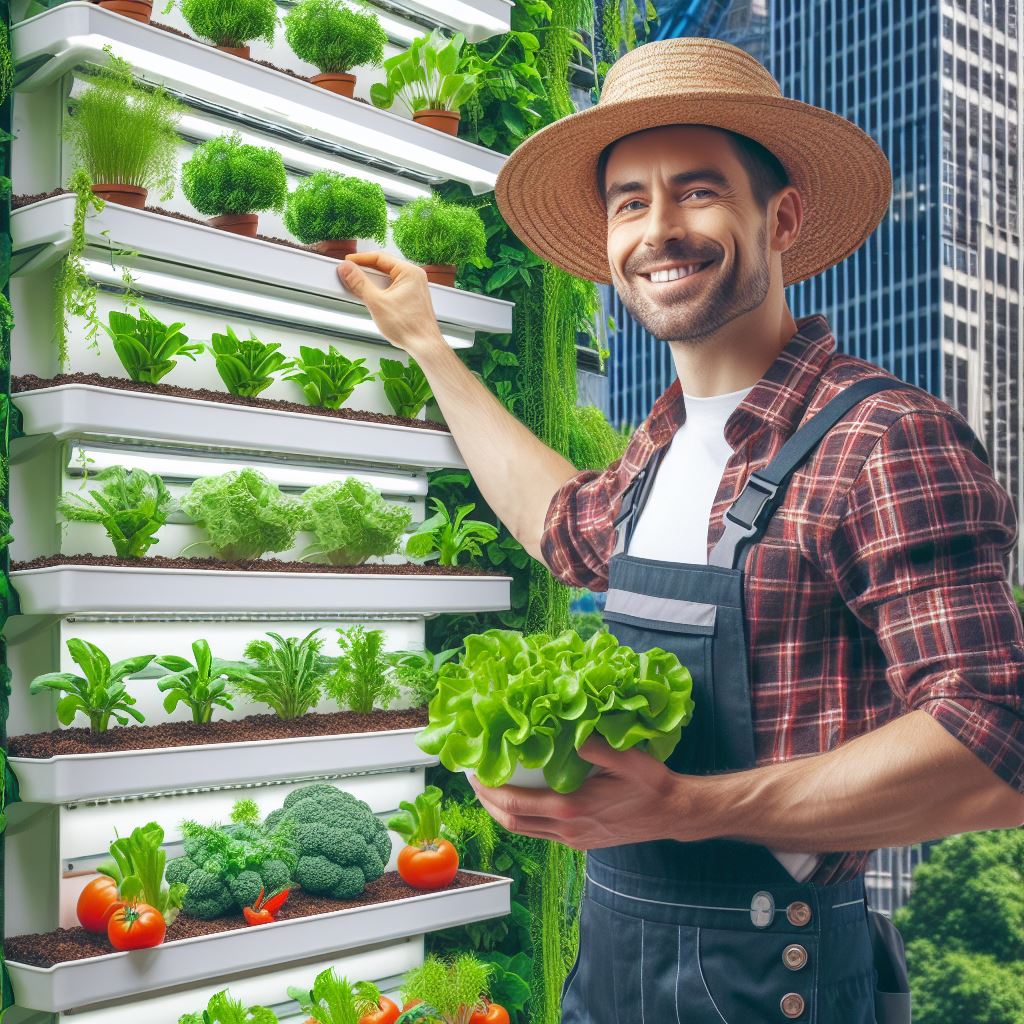Urban Farming: Boosting Food Security
Last Updated on January 25, 2024
Introduction
Definition of urban farming
Urban farming refers to the practice of cultivating, processing, and distributing food in urban areas.
It involves growing crops, raising animals, and producing food products within city limits.
With the growing population and limited arable land, urban farming has become essential in ensuring food security.
Importance of food security
Food security is a fundamental aspect of urban farming.
It ensures that all individuals, regardless of their socioeconomic status, have access to sufficient, safe, and nutritious food.
In urban areas, where poverty and food scarcity are prevalent, urban farming plays a vital role in boosting food security.
By bringing food production closer to urban communities, urban farming reduces the distance food needs to travel from farm to plate.
This, in turn, minimizes transportation costs and reduces the carbon footprint associated with food production and distribution.
Additionally, urban farming provides local employment opportunities and fosters community engagement.
Urban farming also promotes sustainability by utilizing innovative farming techniques such as vertical farming, hydroponics, and rooftop gardens.
These methods maximize space efficiency and reduce water consumption, making urban farming more environmentally friendly compared to traditional agriculture.
Furthermore, urban farming enhances food access by providing fresh, healthy produce in areas classified as food deserts.
These are locations where residents lack access to affordable fresh fruits and vegetables.
By creating urban farms, communities can address food disparities and improve the overall health and well-being of their residents.
Basically, urban farming plays a critical role in boosting food security.
By bringing food production closer to urban communities, it enhances accessibility, promotes sustainability, and addresses food disparities.
As urban populations continue to grow, the importance of urban farming in ensuring a secure and sustainable food system cannot be overstated.
Benefits of Urban Farming
A thriving urban farming industry can bring numerous benefits to communities and individuals.
Let’s explore some of these advantages:
Increased access to fresh and nutritious food
- Urban farming provides local communities with easy access to fresh and nutritious produce.
- By cultivating crops within city boundaries, food can be harvested when it is at its peak freshness.
- Having locally grown food readily available reduces the reliance on long-distance transportation and ensures that consumers receive the freshest possible products.
Reducing the carbon footprint
- Urban farming minimizes the environmental impact associated with long-haul transportation of food.
- When food is produced locally, the need for extensive packaging and refrigeration is significantly reduced.
- By cutting down on these processes, urban farming helps to lower greenhouse gas emissions and conserve energy.
- It also reduces the reliance on chemical inputs, such as pesticides and fertilizers, which further contributes to a greener environment.
Promoting local economy and job opportunities
- Urban farming can stimulate the local economy by creating new job opportunities.
- As the industry expands, more individuals can find employment in various roles, including farming, distribution, marketing, and sales.
- Moreover, urban farming encourages entrepreneurship, allowing individuals to start their own small-scale farming enterprises and contribute to the local economy.
Fostering community engagement and empowerment
- Urban farming fosters a sense of community involvement and empowerment.
- Residents can actively participate in the cultivation of their food, fostering a stronger connection to the environment and the community.
- By engaging in urban farming initiatives, individuals gain a sense of pride and accomplishment.
- Community gardens and urban farms also serve as gathering spaces, promoting social interaction and cohesion among neighbors.
In short, urban farming brings a multitude of benefits to local communities.
It increases access to fresh and nutritious food, reduces the carbon footprint, promotes the local economy and job opportunities, and fosters community engagement and empowerment.
By embracing urban farming, we can create more sustainable and resilient cities while ensuring food security for all.
Read: Vertical Farming: Scaling New Heights
Challenges of Urban Farming
Urban farming is gaining popularity as a sustainable solution to boost food security in cities.
However, it is not without its challenges.
In this , we will explore the various obstacles urban farmers encounter in their quest to cultivate food in urban environments.
Limited space and land availability
One of the primary challenges faced by urban farmers is the scarcity of space and land for farming.
In overcrowded cities, finding suitable areas to grow crops can be extremely difficult.
High real estate prices and competing land uses pose significant barriers to urban agriculture.
Urban farmers have to be creative and make the most of limited spaces.
Rooftop gardens, vertical farming systems, and community gardens are some innovative approaches that help optimize available urban land.
These strategies allow farmers to maximally utilize space and achieve higher crop yields.
Dealing with urban pollution
Another significant challenge in urban farming is the presence of pollution in urban environments.
Air pollution from vehicles and industrial activities can have detrimental effects on plant growth and health.
Water contamination with heavy metals and chemicals poses risks to both plants and consumers.
Urban farmers need to implement measures to combat pollution.
Installing appropriate air filtration systems and using organic farming practices can reduce the negative impacts of air pollution.
Implementing water filtration and purification techniques can ensure the safety of irrigation water and protect crops from contamination.
Access to resources, such as water and soil
Water and soil are fundamental resources required for farming.
However, urban farmers often struggle to secure these resources in sufficient quantities and quality.
Water scarcity and poor soil conditions can hinder crop growth and productivity.
To overcome these challenges, urban farmers employ innovative techniques for water management.
These include rainwater harvesting, utilizing greywater from households, and implementing efficient irrigation systems.
Additionally, urban farmers use specialized techniques like hydroponics and aquaponics that require minimal soil and conserve water.
Overcoming potential regulatory hurdles
Urban farming may face regulatory hurdles imposed by local authorities.
Zoning laws, permits, and restrictions on land use can limit the scale and types of agricultural activities allowed in urban areas.
Navigating these regulations can be complex and time-consuming for aspiring urban farmers.
Effective communication and collaboration with local officials and policymakers are crucial in addressing regulatory challenges.
Advocacy for policy changes that promote urban farming and actively participating in public consultations can help to overcome potential regulatory hurdles.
Generally, while urban farming presents immense opportunities for enhancing food security, it also comes with its fair share of challenges.
Limited space and land availability, dealing with urban pollution, accessing essential resources like water and soil, and overcoming regulatory hurdles are key obstacles that urban farmers need to confront.
However, with innovation, perseverance, and collaboration, these challenges can be overcome, leading to a more sustainable and secure future of urban agriculture.
Read: Aquaponics in Cities: A Green Wave
Innovative Methods of Urban Farming
Rooftop gardening and vertical farming
Rooftop gardening and vertical farming are innovative methods of urban farming that have gained popularity in recent years.
These techniques involve utilizing the space on rooftops and vertical structures to grow food.
Rooftop gardening involves setting up gardens on the rooftops of buildings, whether they are residential, commercial, or industrial.
This method allows urban dwellers to grow their own food in limited spaces.
The advantages of rooftop gardening include reducing the urban heat island effect, improving air quality, and providing access to fresh and healthy produce.
Vertical farming takes urban farming to the next level by utilizing vertical spaces such as tall buildings or multi-story structures.
This method makes use of stacked layers or shelves to grow crops.
With advanced lighting, irrigation systems, and climate controls, vertical farming can produce large amounts of food in a smaller footprint compared to traditional farming methods.
It is an effective way to maximize the use of urban spaces and increase food production.
Hydroponics and aeroponics systems
Hydroponics and aeroponics are soil-less farming techniques that allow plants to grow in nutrient-rich water or air.
These methods are gaining popularity in urban farming due to their efficiency and water-saving capabilities.
Hydroponics is a technique where plants are grown in water-based solutions with added nutrients.
The roots are submerged in the nutrient solution, allowing the plants to absorb the necessary elements for growth.
This method conserves water as it uses only a fraction of what traditional farming requires.
Hydroponics also eliminates the need for pesticides and allows for year-round cultivation.
Aeroponics, on the other hand, involves growing plants in a misty air environment.
The roots hang in the air and are periodically misted with nutrient-rich solutions.
This technique allows for optimal nutrient absorption by the plants while using minimal water.
Aeroponics is considered an efficient method of farming as it promotes faster growth and higher yields compared to traditional soil-based cultivation.
Community gardens and urban agriculture initiatives
Community gardens and urban agriculture initiatives are grassroots movements that aim to involve communities in growing their own food.
These initiatives play a crucial role in promoting food security and bridging the gap between urban environments and agriculture.
Community gardens are plots of land that are collectively cultivated by a group of individuals or organizations.
They provide green spaces in urban areas and allow people without access to land to grow their own food.
These gardens foster community engagement, education, and resource sharing.
Urban agriculture initiatives, on a larger scale, bring together various stakeholders including governments, NGOs, and local communities to establish sustainable urban farming projects.
These initiatives often involve converting unused urban spaces or vacant lots into productive agricultural areas.
They aim to address food disparities, reduce food miles, and increase access to fresh produce.
Essentially, innovative methods of urban farming such as rooftop gardening, vertical farming, hydroponics, aeroponics, community gardens, and urban agriculture initiatives are revolutionizing the way we approach food production in urban areas.
These techniques not only boost food security but also promote environmental sustainability and community engagement.
By embracing these methods, we can create a more sustainable and resilient food system for our cities.
Read: Hydroponics: Future of Urban Farming
Successful Examples of Urban Farming
Growing food in abandoned lots or vacant buildings
- Many cities have successfully transformed abandoned lots into thriving urban farms.
- These vacant spaces are ideal for growing fresh produce and reducing food deserts.
- Urban farmers utilize innovative techniques such as vertical farming to maximize space.
- Local communities are actively involved, providing labor and support for these projects.
- Abandoned lots turned urban farms not only increase food security but also beautify the neighborhood.
- Examples include Detroit’s urban farms that have turned vacant lots into vibrant organic gardens.
- The success of these projects proves the potential for urban farming in revitalizing neglected areas.
- Urban farming not only brings fresh food but also creates job opportunities and promotes community engagement.
- Municipalities play a crucial role in providing the necessary support and resources for these projects to flourish.
- Growing food in abandoned lots fosters a sense of ownership and empowerment among community members.
Collaborations with local restaurants and grocery stores
- Collaboration with local businesses strengthens the urban farming movement.
- Urban farms can supply fresh produce directly to restaurants and grocery stores.
- This reduces the dependency on long-distance transportation and supports the local economy.
- Restaurants benefit from being able to source high-quality, locally grown ingredients.
- Grocery stores can showcase and promote the urban farm’s produce, attracting environmentally conscious customers.
- Collaborations can also include partnerships for composting initiatives, completing the food cycle sustainably.
- These partnerships provide a reliable market for urban farmers, ensuring their economic viability.
- Successful examples include New York City’s rooftop farms that supply fresh produce to nearby restaurants.
- Collaboration with businesses also builds awareness and educates the local community about sustainable food systems.
- Urban farming fosters mutually beneficial relationships between farmers and local businesses.
Implementation of urban farming projects in schools
- Integrating urban farming into educational institutions educates and empowers the younger generation.
- Schools can introduce students to the importance of food security and sustainable agriculture.
- Urban farming projects in schools serve as practical learning experiences for students.
- Children gain hands-on knowledge about growing their food and the importance of healthy eating.
- Urban farms in schools can provide the cafeteria with fresh produce, improving the quality of school meals.
- Students take pride in contributing to the school’s food supply and learn the value of self-sufficiency.
- Schools can collaborate with local farmers or organizations to design and implement these projects.
- Successful examples include schools in Chicago that have established rooftop gardens.
- The implementation of urban farming projects in schools fosters environmental stewardship and community involvement.
- It equips students with essential skills and knowledge to tackle food security challenges in the future.
In general, successful examples of urban farming include transforming abandoned lots into thriving farms, collaborating with local businesses, and implementing projects in schools.
These innovative approaches not only boost food security but also enhance community engagement, support local economies, and educate the younger generation about sustainable agriculture.
Urban farming has the potential to transform neglected areas into vibrant, self-sufficient communities, ensuring a more secure and sustainable food future.
Read: Regenerative Agriculture 101

Government and Policy Support
Urban farming is an essential component of boosting food security in cities.
As the global population continues to grow and urban areas become more densely populated, ensuring access to fresh, nutritious food becomes increasingly challenging.
However, through government and policy support, urban farming can play a significant role in addressing this issue.
Encouraging urban farming through incentives and grants
One way the government can support urban farming is by providing incentives and grants.
These financial incentives can help individuals and communities start and maintain urban farms.
For example, the government could offer tax breaks or subsidies to offset the costs of purchasing land, equipment, and seeds.
By reducing the financial burden, more people will be motivated to engage in urban farming as a viable means of food production.
Creating zoning regulations to protect urban agriculture
Zoning regulations are another critical aspect of government support for urban farming.
These regulations define how land can be used in different parts of the city.
By creating specific zones for urban agriculture, the government can protect agricultural activities from encroachment by other types of development.
This ensures that urban farms have secure access to land and are not displaced by urban expansion.
Partnering with local organizations and businesses
Government support for urban farming can also involve partnerships with local organizations and businesses.
By collaborating with non-profit organizations, community groups, and businesses, the government can leverage resources and expertise to promote urban farming.
These partnerships can result in the sharing of knowledge, access to funding, and the creation of community gardens and green spaces.
Local organizations and businesses can also play a vital role in supporting urban farming through initiatives such as farmer training programs or purchasing agreements.
By offering training programs, urban farmers can develop the necessary skills and knowledge to succeed.
Additionally, businesses can commit to purchasing a portion of their produce from local urban farmers, ensuring a stable market for their products.
In essence, government and policy support are crucial for boosting food security through urban farming.
By providing incentives and grants, creating zoning regulations, and partnering with local organizations and businesses, governments can create a conducive environment for urban farming to thrive.
This, in turn, will contribute to increased access to fresh, nutritious food in urban areas and enhance food security for all residents.
Future Outlook on Urban Farming
Potential expansion and scalability
Urban farming has the potential for significant expansion and scalability in the future.
As the demand for locally grown, sustainable food continues to rise, urban farmers can capitalize on this trend by increasing the size and reach of their operations.
This could involve converting vacant lots, rooftops, and other underutilized spaces into productive agricultural land.
By maximizing available resources and implementing efficient farming techniques, urban farmers can expand their production capacity and meet the growing demand for fresh, locally sourced food.
Additionally, urban farming can be scaled up through the establishment of community gardens and cooperative farming initiatives.
By pooling resources and sharing knowledge, communities can work together to create larger, more efficient urban farming systems.
This collaborative approach not only increases the overall productivity of urban agriculture but also fosters a sense of community and enhances food security at the local level.
Integration of technology and innovation
The future of urban farming lies in the integration of technology and innovation.
With advancements in robotics, sensor technology, and data analytics, urban farmers can optimize their operations and improve productivity.
Automated systems can be used to monitor and control various aspects of the farming process, such as irrigation, fertilization, and pest control.
This not only reduces labor costs but also ensures more precise and efficient resource utilization.
Moreover, the use of vertical farming techniques, hydroponics, and aeroponics allows for the cultivation of crops in controlled indoor environments.
By leveraging these innovative methods, urban farmers can overcome the limitations of traditional agriculture, such as limited space and dependence on weather conditions.
This enables year-round production and the cultivation of a wide variety of crops, ensuring a stable and diverse food supply.
Collaboration between urban and rural agriculture
The future outlook on urban farming also involves collaboration between urban and rural agriculture.
By fostering a symbiotic relationship, both sectors can benefit from each other’s strengths.
Urban areas can provide a market for rural farmers, who might face challenges in reaching urban consumers due to distance and transportation costs.
On the other hand, rural areas can supply urban farmers with essential resources like land, water, and organic waste for composting.
This collaboration can be further enhanced through the establishment of food hubs and distribution networks that connect urban and rural agriculture.
These hubs can facilitate the exchange of produce and knowledge, ensuring a more efficient and sustainable food system.
By bridging the gap between urban and rural areas, this collaboration not only strengthens local economies but also improves food security by diversifying the sources of food production.
In a nutshell, the future of urban farming looks promising.
With potential for expansion and scalability, integration of technology and innovation, and collaboration between urban and rural agriculture, urban farming can play a significant role in boosting food security.
By capitalizing on these opportunities, urban farmers can contribute to the development of a more sustainable and resilient food system.
Conclusion
Recap of the importance of urban farming for food security
Urban farming plays a crucial role in ensuring food security in our cities.
By utilizing available spaces, we can grow fresh produce locally and reduce our dependency on external sources.
Encouragement for individuals to get involved in urban farming initiatives
We should actively participate in urban farming initiatives by starting small gardens in our balconies or joining community gardens.
By doing so, we can contribute to our own food production and strengthen food security.
Final thoughts on the potential of urban farming to boost food security
Urban farming has immense potential to address the challenge of food security.
It not only provides access to nutritious food but also promotes sustainable practices and builds resilient communities.
By embracing urban farming, we lay the foundation for a secure and sustainable future.


